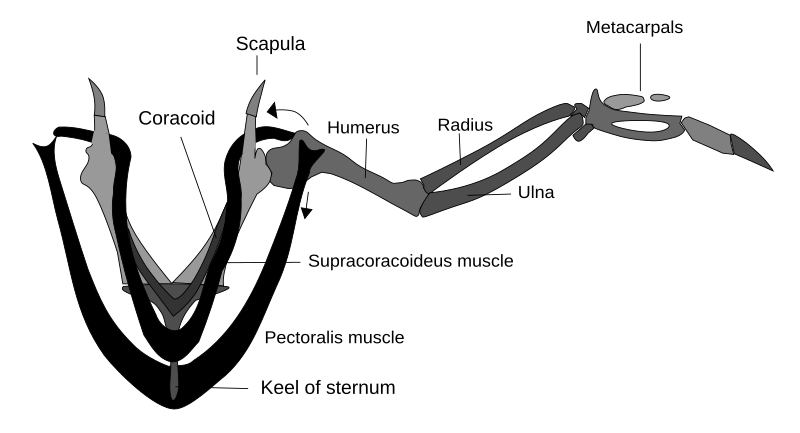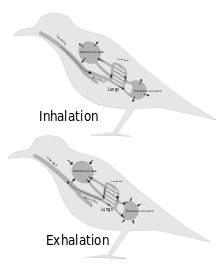 Respiratory System
Respiratory SystemDue to their high metabolic rate required for flight, birds have a high oxygen demand. Development of an efficient respiratory system enabled the evolution of flight in birds. Birds ventilate their lungs by means of air sacs.
These sacs do not play a direct role in gas exchange, but act like bellows to move air through the respiratory system, allowing the lungs to maintain a fixed volume with fresh air constantly flowing through them.[1]
Three distinct sets of organs perform respiration—the anterior air sacs (interclavicular, cervicals, and anterior thoracics), the lungs, and the posterior air sacs (posterior thoracics and abdominals). The posterior and anterior air sacs, typically nine, expand during inhalation. Air enters the bird via the trachea. Half of the inhaled air enters the posterior air sacs, the other half passes through the lungs and into the anterior air sacs. Air from the anterior air sacs empties directly into the trachea and out the bird's mouth or nares. The posterior air sacs empty their air into the lungs. Air passing through the lungs as the bird exhales is expelled via the trachea. Some taxonomic groups (Passeriformes) possess 7 air sacs, as the clavicular air sacs may interconnect or be fused with the cranial thoracic air sacs.
As air flows through the air sac system and lungs, there is no mixing of oxygen-rich air and oxygen-poor, carbon dioxide-rich, air as in mammalian lungs. Thus, the partial pressure of oxygen in a bird's lungs is the same as the environment, and so birds have more efficient gas-exchange of both oxygen and carbon dioxide than do mammals. In addition, air passes through the lungs in both exhalation and inspiration.
Avian lungs do not have alveoli, as mammalian lungs do, but instead contain millions of tiny passages known as parabronchi, connected at either ends by the dorsobronchi and ventrobronchi. Air flows through the honeycombed walls of the parabronchi into air vesicles, called atria, which project radially from the parabronchi. These atria give rise to air capillaries, where oxygen and carbon dioxide are traded with cross-flowing blood capillaries by diffusion.[2]
Birds also lack a diaphragm. The entire body cavity acts as a bellows to move air through the lungs. The active phase of respiration in birds is exhalation, requiring muscular contraction.
The syrinx is the sound-producing vocal organ of birds, located at the base of a bird's trachea. As with the mammalian larynx, sound is produced by the vibration of air flowing through the organ. The syrinx enables some species of birds to produce extremely complex vocalizations, even mimicking human speech. In some songbirds, the syrinx can produce more than one sound at a time.


No comments:
Post a Comment